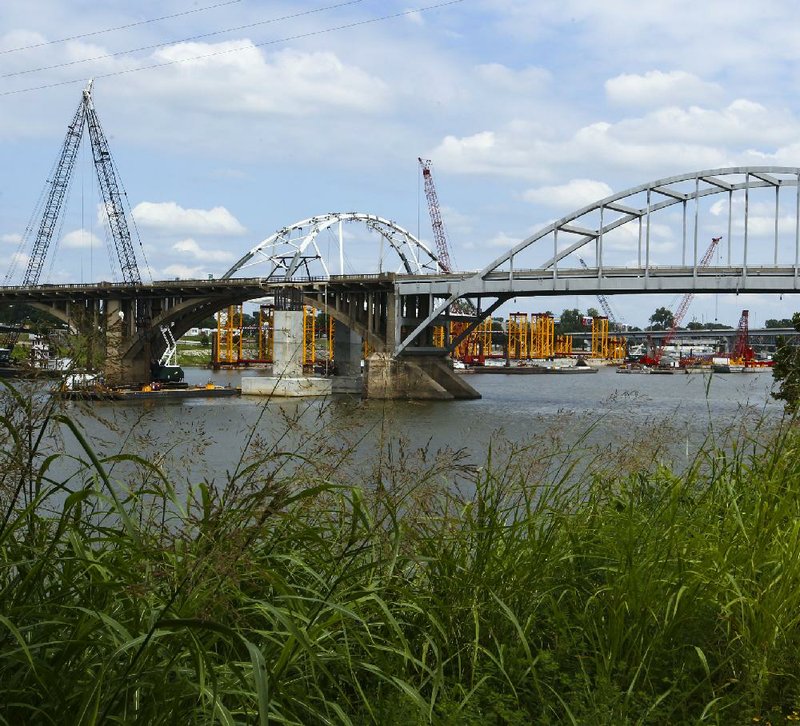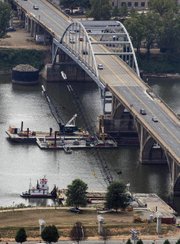The 93-year-old Broadway Bridge over the Arkansas River between downtown Little Rock and North Little Rock will close Sept. 28 to allow it to be dismantled and replaced, state highway officials announced Thursday.
Reader poll
How will you get between Little Rock and North Little Rock when the Broadway Bridge is closed?
- Interstate 30
- Interstate 430
- Interstate 440
- Main Street
- One of the pedestrian bridges
- By boat
- I'll stop traveling between them
509 total votes.
RELATED ARTICLE
http://www.arkansas…">Work on bridge to shift downtowns’ traffic flow
From that date, the contractor for the $98.4 million project, Massman Construction Co. of Kansas City, Mo., will have no more than 180 days, or about six months through the heart of winter, to open the new bridge to traffic, with no allowances for weather or the flow or depth of the river. Under the terms of the contract, Massman can be docked $80,000 for each day it exceeds the 180 days or draw an identical amount in bonuses for every day it is under the time limit.
Scott Bennett, the director of the Arkansas Highway and Transportation Department, said officials with the agency and Massman are confident the work can be accomplished within six months.
"We have as high a degree of confidence as you can have," Bennett said after a midday meeting Thursday between state highway officials, the contractor and local officials to discuss the status of the project.
They also said the five weeks' notice before the bridge closing will allow the 25,000 motorists who now use it to consider other options to cross the river.
"We did want to give the public as much notice as possible to plan their alternative routes," Bennett said.
Little Rock Mayor Mark Stodola said he doubts that the firm date will catch many motorists off guard.
"I think the traveling public has been anticipating this for a long time," he said. "I encourage them to practice new, alternative routes. The more they do that, the better we will be prepared."
The Sept. 28 date could be adjusted depending on river conditions, Bennett said.
"It could slide a few days," he said. "Could something happen upstream that will change the height or flow of the river? Maybe.
"There's a lot that can happen in five weeks. But we're as confident as we can be at this point that Sept. 28 is a good date for the bridge to be closed."
The closing date was set, in part, to give the contractor enough time to float the new bridge's two arches into place before expected seasonal changes in river conditions, Bennett said. By Nov. 20, he said, river depth and flows would, according to historical data, make it too difficult to conduct work in the river.
Construction crews want to float the two arches into place before Nov. 20, he said. They will need river flow to be relatively normal because the barges on which the arches sit will have to be perpendicular to the flow when they are positioned. The river also cannot be too high or Massman won't be able to sink the barges enough to lower the arches into place.
Even if Massman gets that work done before the seasonal change, much work will remain to be done before the new bridge can be opened to traffic, Bennett said.
Among other things, the arches will have to be tied together, the tension wires tightened and the concrete poured for the bridge deck.
"Some winters are maybe OK for setting concrete," he said. "Some are not. It's going to be a challenge at every step of the process."
The existing bridge will come down in stages, with the early work being performed with heavy machinery. But it won't dismantled immediately.
Some preparation work will have to be performed first, said Danny Straessle, a Highway Department spokesman. For instance, workers will have to mill off and remove asphalt on the bridge first because the U.S. Army Corps of Engineers, which exercises some regulatory powers over navigable bodies of water like the Arkansas River, doesn't want any asphalt going into the river, he said.
At least three phases will involve the use of cutting charges and other explosives to remove the concrete arches under the bridge, the steel arch and the footings. The dates for blasting will be announced in advance, the department said.
The old bridge is being dismantled to accommodate work on the new bridge. The old bridge deck will be removed first to allow workers to finish constructing piers for the new bridge, because the new piers will be higher than the old deck, Bennett said.
One of the arches already has been built. All the steel for the second arch already has been fabricated, Bennett said, adding that he expects the second arch to be built more quickly than the first because the workers have the experience of building the first one.
The bridge originally was set to be closed from May to November, but high water and flow rates higher than normal slowed work in the river. Also, the fabrication and delivery of the steel didn't proceed as originally scheduled.
That delay, Bennett said, allowed workers to complete additional work, which will make it more likely that Massman, an experienced bridge builder, will be able to open the new bridge to traffic in less than six months.
The work is being performed under a contract Massman was awarded in September 2014. At the time, the $98.4 million contract was the single-largest the department had ever awarded.
By contrast, the original bridge was completed for $971,000. Although it opened to traffic in December 1922, it wasn't completed until the spring of 1923. Straessle said he expects it will take another two months to complete the work on the new bridge after it opens to traffic.
Additional work was done on the old bridge in 1972. Two spans on the south end of the bridge were removed to make way for a wider navigation span when the Corps of Engineers developed the McClellan-Kerr Arkansas River Navigation System.
The single, silver-colored arch that has become awidely recognized part of Little Rock's skyline was paid for by the Corps of Engineers at an approximate cost of $2.5 million.
In its place will be a bridge that incorporates two basket-handle arches. The Highway Department had proposed just one arch, but Pulaski County committed an extra $20 million for the additional arch. That money will be paid over several years.
Work to replace the bridge, which is on U.S. 70, began in 2011 after the department determined that all three of its components -- the superstructure, substructure and deck -- were rated as structurally deficient.
While state highway officials say the bridge remains safe, it has been increasingly costly to maintain, making replacing it a more cost-effective option.
Metro on 08/26/2016


